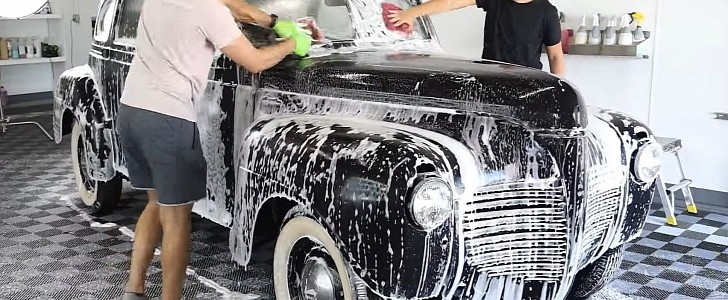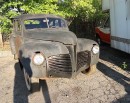Classic cars look their best in Concours-ready shape, but barn-found examples are also cool if they're still in one piece and ready to roll. Sadly, long-term storage is not a classic car's best friend, so most cars see daylight with serious damage caused by rust.
It usually takes only a couple of decades to render a classic unsalvageable. But some vehicles manage to soldier on through 40 to 50 years with a surprisingly low amount of rust damage. This early 1940s Plymouth, for instance, took a whopping 70 years of storage like a champ.
Featured by "WD Detailing," this four-door sedan came out of the barn earlier in 2022, which means it was parked all the way back in 1952. Now that's something you don't see very often. There's no word as to why it was retired after only a decade on the road, but there are no signs that the car was involved in a crash.
In fact, the bodywork appears to be quite solid from nose to tail, with straight body panels and only a bit of surface rust. Yes, most of the chrome trim is missing, but it was actually stored inside the cabin.
Speaking of which, the interior is also in very good condition. Not only complete, but the original upholstery is still there and, surprisingly enough, the Plymouth still has floor panels. In addition, the folks over at "WD Detailing" claims there's structural damage whatsoever.
The old Mopar arrived at the shop for a full cleaning and detailing, its first in seven decades. Where's all the dust and dirt, you ask? Well, the car spent a few days outside and the rain washed most of the grime.
But while the process might not be as satisfying to watch, it still makes a big difference and reveals a beautiful patina that combines surface rust with worn-out black paint. The front grille still shines, but that's because it spent all those years locked inside the cabin.
So is this Plymouth worth restoring or will it end up as a parts car? Well, the mechanic checking it out at the end of the video says the car will need about $4,000 to $5,000 in parts just to run, drive, and stop again. That's not bad, but a full restoration would cost more than the market value of a Concours-ready Plymouth from the era.
All told, this Mopar would be better off as a project car. It already looks like a rat rod, so all it needs is a powerful and more modern powerplant under the hood. Hopefully, we'll see it back on the road soon enough.
If you're not familiar with Plymouths from this era, the four-door you're looking at is part of the De Luxe series. The full-size was introduced in 1933 and remained in production until 1942 when U.S. automobile production was halted during WW2. The nameplate returned from 1946 to 1950.
The De Luxe went through many redesigns, evolving from a typical 1930s automobile to a more streamlined design. This particular version appears to be a 1940 model of the range-topping Special De Luxe variety. Power came from a 201-cubic-inch (3.3-liter) inline-six rated at 87 horsepower that year.
Featured by "WD Detailing," this four-door sedan came out of the barn earlier in 2022, which means it was parked all the way back in 1952. Now that's something you don't see very often. There's no word as to why it was retired after only a decade on the road, but there are no signs that the car was involved in a crash.
In fact, the bodywork appears to be quite solid from nose to tail, with straight body panels and only a bit of surface rust. Yes, most of the chrome trim is missing, but it was actually stored inside the cabin.
Speaking of which, the interior is also in very good condition. Not only complete, but the original upholstery is still there and, surprisingly enough, the Plymouth still has floor panels. In addition, the folks over at "WD Detailing" claims there's structural damage whatsoever.
The old Mopar arrived at the shop for a full cleaning and detailing, its first in seven decades. Where's all the dust and dirt, you ask? Well, the car spent a few days outside and the rain washed most of the grime.
But while the process might not be as satisfying to watch, it still makes a big difference and reveals a beautiful patina that combines surface rust with worn-out black paint. The front grille still shines, but that's because it spent all those years locked inside the cabin.
So is this Plymouth worth restoring or will it end up as a parts car? Well, the mechanic checking it out at the end of the video says the car will need about $4,000 to $5,000 in parts just to run, drive, and stop again. That's not bad, but a full restoration would cost more than the market value of a Concours-ready Plymouth from the era.
All told, this Mopar would be better off as a project car. It already looks like a rat rod, so all it needs is a powerful and more modern powerplant under the hood. Hopefully, we'll see it back on the road soon enough.
If you're not familiar with Plymouths from this era, the four-door you're looking at is part of the De Luxe series. The full-size was introduced in 1933 and remained in production until 1942 when U.S. automobile production was halted during WW2. The nameplate returned from 1946 to 1950.
The De Luxe went through many redesigns, evolving from a typical 1930s automobile to a more streamlined design. This particular version appears to be a 1940 model of the range-topping Special De Luxe variety. Power came from a 201-cubic-inch (3.3-liter) inline-six rated at 87 horsepower that year.









